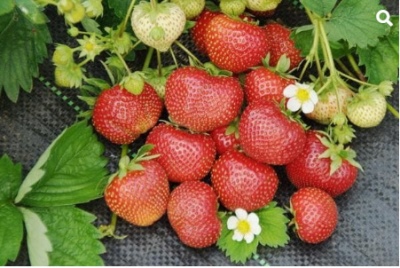
- Authors: Leningrad Experimental Station G.D. Alexandrova
- Taste: sweet and sour
- The size: large
- Weight: 12 -35 gr
- Yield rate: high
- Yield: 72.5 kg from 1 are
- Repairability: No
- Ripening terms: medium
- Description of the bush: sprawling, leafy
- Berry color: bright red
The unrepaired variety Sudarushka is quite popular both among farmers who grow strawberries for sale and among private gardeners. It is appreciated for its good winter hardiness, undemanding growing conditions. Sudarushka is equally good both fresh and in compotes or jam.
Breeding history of the variety
The variety was obtained at the Leningrad experimental station of G. D. Aleksandrova. When crossing large-fruited garden strawberries Festivalnaya and Roxana were used. The variety is included in the State Register of the Russian Federation.
Description of the variety
Strawberries are vigorous. The bushes are spreading, but rather tall, powerful, well leafy. Peduncles are located under the outlet or flush with it. The mustache is pink in color and is considerable in length.
Ripening terms
Sudarushka belongs to varieties with an average fruit ripening period.
Growing regions
The Sudarushka strawberry was bred in the climatic zone of the North-West region. It is successfully cultivated in the Leningrad region and the Moscow region, there is experience in growing bushes in the south and in Siberia.
Yield
With proper agricultural technology, you can collect up to 72.5 kg from 1 are. The variety is considered to be high yielding.
Berries and their taste
Large bright red berries with dense sweet and sour pink flesh are formed on strawberry bushes. The average fruit weight is 12-35 grams. The shape of the berry is oval, clear. The aroma is fresh, strawberry. The surface of the berry is glossy, the achenes are located superficially, have a yellow color.
Growing features
Sudarushka is grown on fertile soils. It is recommended to mulch the surface of the beds with straw, replacing it in time after watering and fertilizing. After harvesting, the beds must be cleaned, removed old mustaches, foliage. This allows new flower buds to form on the plant before frost, laying the foundation for next year's harvest. Pruning is performed in the 3rd decade of July, without delaying it.




Site selection and soil preparation
The place can be chosen open, shading is optional. Strawberry Sudarushka grows well in sunny areas. In poor soils, it is good to first add peat or other organic additives - manure, compost and wood ash. The best soil is black soil.
Sour soils are contraindicated for Sudarushka, she needs 5.2-5.5 pH values. If the indicators are higher, it is worth 1-2 years before planting strawberries to deoxidize with dolomite flour, simply digging a site with it.
Planting of plants is carried out in the spring, in a warmed-up soil. It is also possible to prepare a new plantation at the end of July, from a mustache. In this case, the harvest can be expected next year. Planting can be carpet, without trimming the whiskers, with ribbons - in a row with a distance of 25-30 cm or nesting with 1 plant in the center and 4 around it.

Pollination
There is no need to pollinate the plants specially. A sufficient number of flowers are formed, they give a lot of ovaries.
Top dressing
Strawberries need feeding after harvest. The optimal choice for application at the end of summer will be a complex fertilizer for this type of plants. It is applied to the soil in the proportion of 300 g / m2 of the ridge area. Organic feeding will also be useful; chicken droppings, highly diluted with water (1 in 20), will do. 1 liter of solution is poured under the root of the bush to avoid burns of the green mass.
In spring, nitrogen is introduced into the soil - in the form of saltpeter in bulk or a weak solution of chicken droppings. With the beginning of the formation of flower buds, it is worth supplementing the feeding with potassium at a dosage of 35 g per 1 m2, in granules.

One of the important techniques in strawberry care is feeding. Regular fertilization guarantees a rich harvest. There are several different ways to feed strawberries, and each of them is designed for a specific period of plant development. During flowering, fruiting and after it, feeding should be different.

Diseases and pests
The resistance of the variety to damage by strawberry mites is average. Leaves, berries and roots are rarely affected by fungal diseases. You can even do without preventive fungicidal treatment during the season. But at the end of fruiting, it is recommended to take measures to protect against pests. After pruning, the plants are treated with a colloidal sulfur solution or Fitoverm.

Strawberries are often subject to many dangerous diseases that can seriously undermine their condition. Among the most common are powdery mildew, gray mold, brown spot, anthracnose, and verticillosis. Before buying a variety, you need to inquire about its disease resistance.
Reproduction
Strawberries form rosettes abundantly. Reproduction in garden plots is carried out precisely by the mustache, which is rooted in the same garden bed or immediately in separate containers.

Review overview
The variety Sudarushka receives pretty good reviews from gardeners. It is appreciated for the attractive appearance of the fruits - they do not deform even when freezing and subsequent defrosting. And also the plants are praised for a stable yield, noting that the duration of fruiting can be increased by building a film shelter. Experienced gardeners recommend increasing the height of the beds with Sudarushka strawberries, if the region of its cultivation is distinguished by an abundance of precipitation, and also covering the soil surface with agrofibre so that the berries remain clean and the soil warms up better.
The disadvantages include only the low resistance of the plant to attacks by weevils and strawberry mites. You have to fight with them throughout the season.


















































































